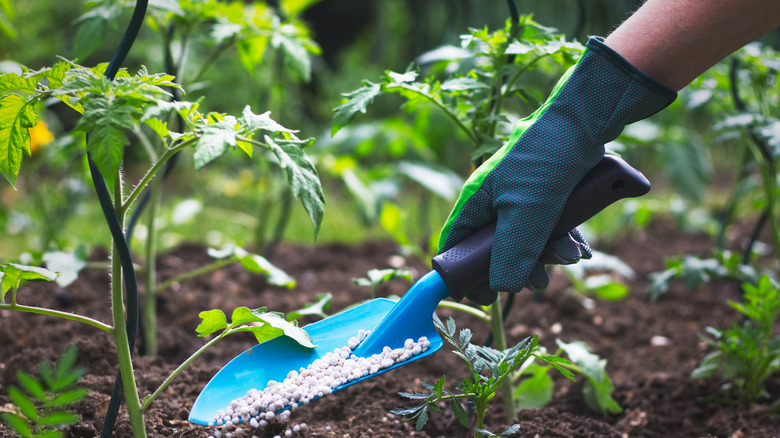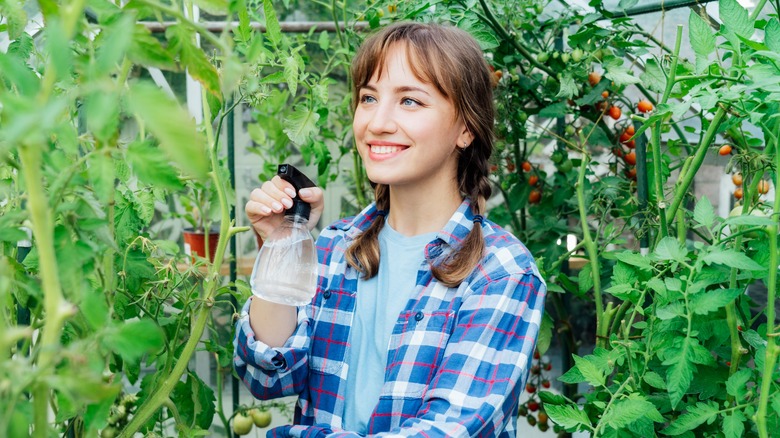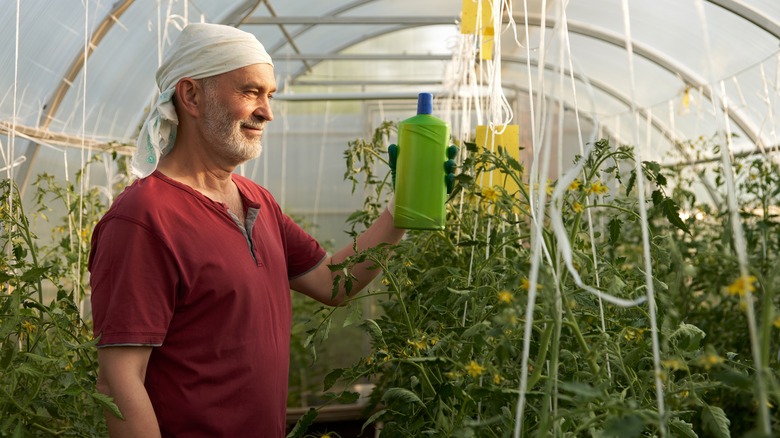Exactly How Often You Should Fertilize Tomato Plants (And Why It Matters)
Successfully cultivating homegrown tomato plants requires healthy servings of good soil, sufficient water, lots of sunshine, and properly formulated (and applied) fertilizer. To set the stage for quality fruits and good yields, fertilize the tomato plants in your garden throughout their growth cycle. First, apply fertilizer at planting time. When your first tomatoes reach one-third of their final size, fertilize them with a side-dressing around each plant's bottom stem. After you pick the first ripe tomato, wait two weeks and repeat the side-dressing. One month after that, apply the final side-dressing to your plants.
Your plants' side-dressings are the nutritional icing on the cake. Each side-dressing adds a nitrogen boost, enabling the tomato plant to produce sufficient leaves and fruits after it moves beyond the flowering stage. Lightly sprinkle soil over the base of each side-dressed plant, reducing the chances that the fertilizer will wash away during a rain.
Finally, stay focused on personal safety while you're fertilizing your tomato plants. Eliminate any distractions, and put away your phone. Most importantly, don't allow fertilizer to touch your eyes or exposed skin. Always wear personal protective gear, and follow the fertilizer package directions to minimize your risks.
Why proper fertilization matters, and how to choose a fertilizer
As with any recipe, mixing the right amount of each ingredient maximizes your odds of success. Applying too little or too much fertilizer can negatively impact your tomato plants' ability to complete their growth cycle and produce healthy fruits. Avoid estimating the fertilizer quantities, as that's a recipe for disaster. So, what's the worst that could happen? For starters, skimping on the tomato plants' fertilizer can cause a nutrient deficit. If an individual plant has substandard nitrogen levels, the entire plant will display a yellowish tint. Too little potassium causes bright yellow edges on older green leaves. Insufficient magnesium results in a yellowish cast between a plant's older leaves' veins. These poor tomato plants are clearly in distress.
On the flip side, overfertilizing your tomato plants can bring a different set of problems. You might be making a core mistake that could negatively impact your tomato yield. Notably, applying too much nitrogen to young plants can burn them. Meanwhile, overloading mature tomato plants with fertilizer results in beautiful leafy plants that don't produce flowers (or tomatoes -– ever).
When you're ready to purchase tomato plant fertilizer, first get your garden soil tested through your county's Cooperative Extension Service office. The test results will provide the soil's nutrient profile and determine whether fertilizer can benefit your plants. If that's the case, the test can also help you select the right nutrient-packed fertilizer. If skipping the test, choose a complete fertilizer with all major and minor nutrients. The major plant nutrients are nitrogen, phosphorus, and potassium. Minor nutrients include calcium, magnesium, and sulfur. There are even some budget-friendly options for tomato plant fertilizer.
Fertilizing container-grown tomato plants
Fresh-from-the-garden container tomatoes are always a tasty treat. Whether you prefer full-sized varieties or smaller cherry or grape tomatoes, you've got plenty of ways to enjoy these gorgeous fruits. Maybe you'll grow your tomato crop on a small sunlit patio; on a spacious, sun-drenched deck; or even in a corner of your yard. Choosing a container-friendly fertilizer and providing the correct nutrient blend will help bring generous yields. Regardless of the container sizes, you'll need to fertilize container tomato plants more often than tomato plants set in your garden. With less soil available to each container plant, they'll need more frequent nutrient boosts.
So, what type of fertilizer would consistently provide those essential nutrients? And when should you start? Begin with a timed-release fertilizer on your planting day, and follow the package recommendations. Two weeks later, begin applying a water-soluble fertilizer once weekly. A fertilizer with a higher phosphorus content (the middle number of the formula) is key to optimal flowering and fruiting.
Finally, remember that your tomato plants are real potassium lovers. Once those beautiful tomato flowers appear, treat your container tomato plants to a high-potassium fertilizer (ideally a specialty tomato blend). Organic growers can use a blend of bone meal, fish emulsion, green sand, and kelp meal. This organic blend should help you achieve similar results to the conventional fertilizer. Either way, you (and your friends and neighbors) will likely soon be enjoying some of the best fruits of summer!


